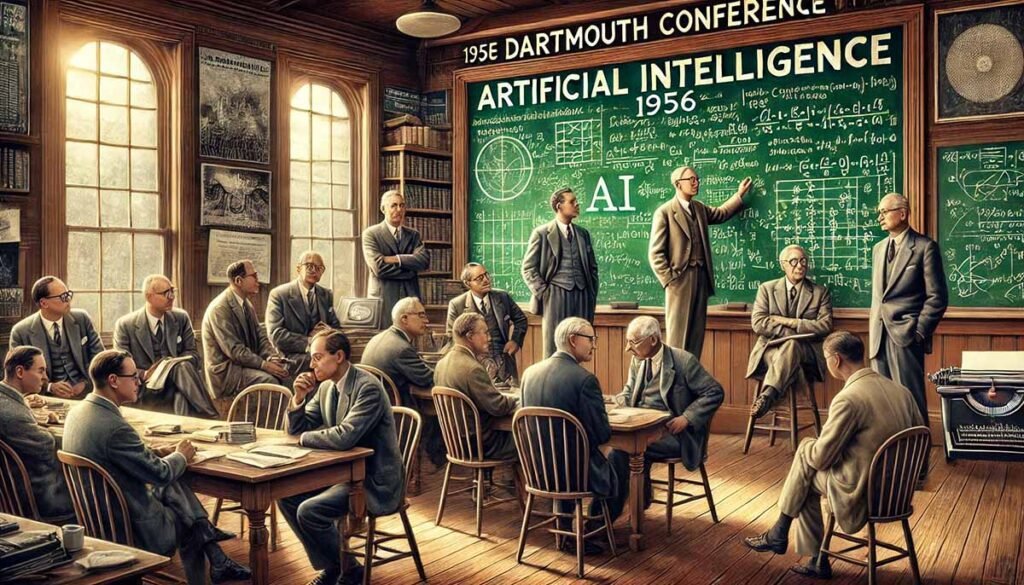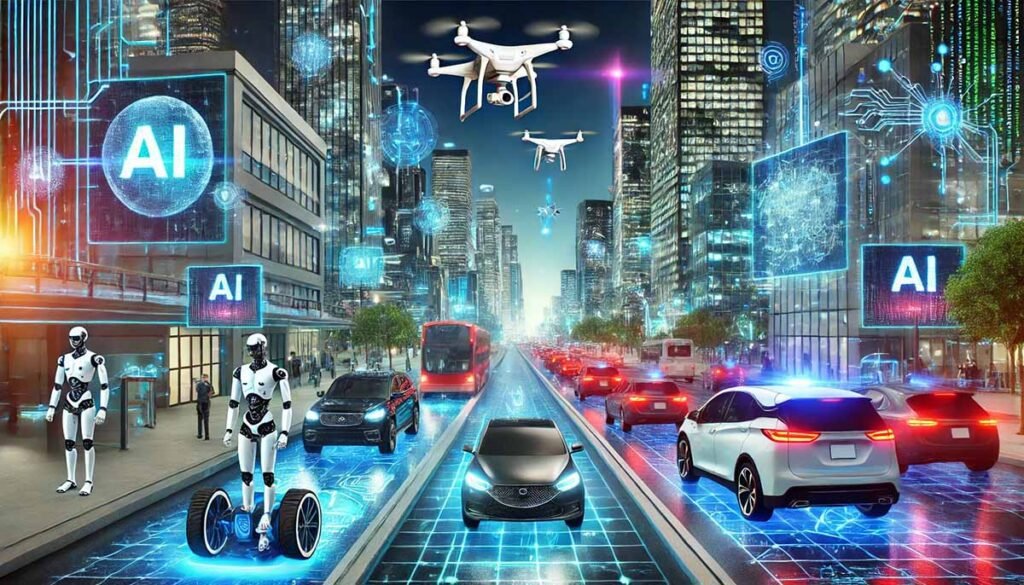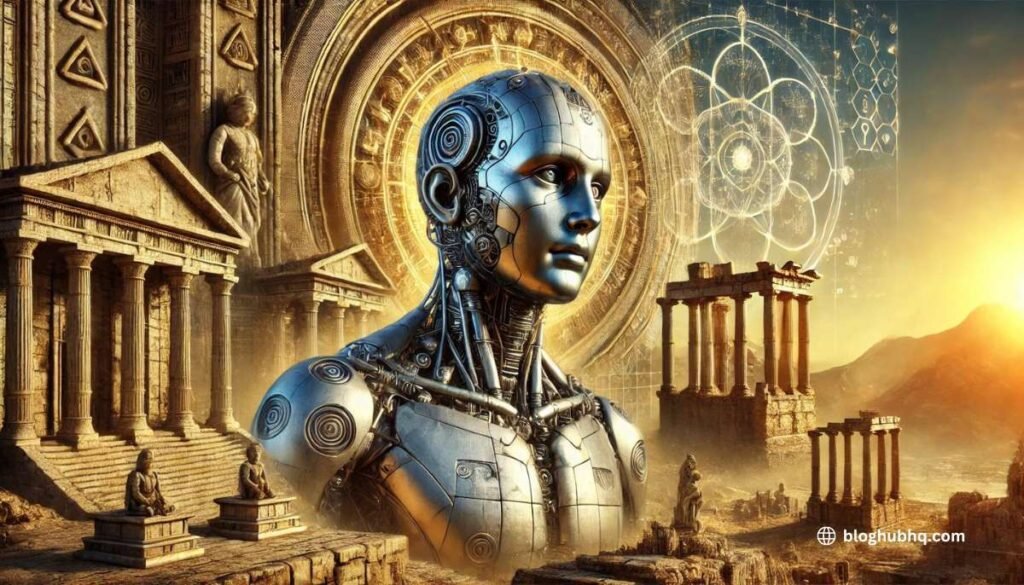The concept of artificial intelligence (AI) has transcended from science fiction. It is a powerful force that is shaping our world today. AI is everywhere, from smart assistants like Siri and Alexa to self-driving cars. But how did we get here? The story of AI is as fascinating as the technology itself.
Artificial Intelligence has its origins in ancient times. Ancient myths spoke of mechanical beings brought to life by gods or magic. These stories sparked the imagination of philosophers and scientists alike. Fast forward to the 20th century, and the idea of machines that could think like humans started to take shape. It was no longer just fantasy.
The journey of AI is a tale of ambition, setbacks, and breakthroughs. Early researchers were optimistic, but the path was not always smooth. There were times when progress stalled and enthusiasm waned. Yet, the dream never died. Today, AI is advancing at an unprecedented pace, bringing us closer to a future where machines could rival human intelligence.
In this article, we will explore the history and evolution of AI. We will look at the milestones that have defined this journey and the challenges that shaped its development. Let us dive into the world of AI and discover how far we have come.
Early Concepts and Precursors to AI
Mythical and Fictional Precursors
The idea of artificial beings is not new. Long before modern technology, humans dreamed of creating life from non-living materials. Ancient myths are filled with tales of such creations.
- Greek Mythology: Take the story of Talos, for example. He was a giant bronze automaton who guarded the island of Crete. According to legend, Talos was made by the god Hephaestus, a symbol of human-like intelligence in a non-human form.
- Medieval Legends: Then there is the Golem, a figure from Jewish folklore. Created from clay and brought to life by mystical means, the Golem served as a protector. This concept echoed humanity’s desire to create life from inanimate objects.
Philosophical Foundations
The philosophical roots of AI go deep. Philosophers like Aristotle laid the groundwork by exploring formal reasoning and logic. These ideas were crucial for developing the concept of a thinking machine.
- Aristotle’s Logic: Aristotle’s work on syllogisms provided the earliest formalized reasoning system. This system was the first step towards thinking about how machines could mimic human thought.
- Leibniz’s Calculating Machine: Fast forward to the 17th century, and we see Gottfried Wilhelm Leibniz imagining a universal language of reasoning. He even designed one of the first mechanical calculators, envisioning a machine that could perform logical operations.
These early concepts set the stage for the development of AI. They show that the dream of creating intelligent machines has existed for centuries, long before the first computer was built.
The Turing Test: Foundations of AI

Introduction to Alan Turing
No discussion about AI is complete without mentioning Alan Turing. Born in 1912, Turing was a brilliant mathematician and logician. He is frequently referred to as the founder of artificial intelligence and computer science. Turing’s work during World War II, particularly in cracking the Enigma code, showcased his genius. But his contributions went far beyond wartime efforts. His ideas laid the foundation for what we now call artificial intelligence.
The Turing Test Explained
In 1950, Turing published a groundbreaking paper titled “Computing Machinery and Intelligence.” In it, he posed a simple yet profound question: “Can machines think?” To address this, Turing introduced what we now call the Turing Test.
- How the Test Works: The Turing Test is intended to gauge a machine’s capacity for intelligent behavior that can be mistaken for human-like behavior. In the test, a human judge interacts with a human and a machine through a computer interface. The judge knows one is a machine but does not know which. If the judge cannot distinguish between the two reliably, the machine is said to have passed the test.
- Why It Matters: The Turing Test shifted the focus from whether machines can think to whether they can convincingly mimic human behavior. This approach made the abstract idea of machine intelligence more tangible and testable.
Impact on AI Development
The Turing Test was a game-changer. It gave AI researchers a clear, practical goal: create machines that can pass as humans in conversation. This idea inspired early AI development, driving researchers to build programs capable of natural language processing, problem-solving, and more.
Turing’s legacy lives on today. While the Turing Test has its critics, it remains a fundamental concept in AI. It set the stage for decades of innovation and continues to be a benchmark for evaluating machine intelligence.
The Dartmouth Conference: Birth of AI as a Field

Background and Context
By the mid-1950s, the idea of machines that could think was gaining traction. Computers were becoming more powerful, and there was a growing belief that these machines could one day mimic human intelligence. Scientists and mathematicians worldwide were exploring various aspects of what we now call artificial intelligence. However, the field was still fragmented, with no clear direction or unified approach. This was the environment leading up to the Dartmouth Conference.
The Dartmouth Conference
In the summer of 1956, a small group of researchers gathered at Dartmouth College in Hanover, New Hampshire. This event, organized by John McCarthy, Marvin Minsky, Nathaniel Rochester, and Claude Shannon, would later be recognized as the official birth of AI as a field of study.
- Purpose of the Conference: The goal was to explore the possibility that “every aspect of learning or any other feature of intelligence can, in principle, be so precisely described that a machine can be made to simulate it.” At this point, John McCarthy first used the term “artificial intelligence” formally.
- Key Participants: The conference brought together some of the brightest minds of the time, including Herbert Simon and Allen Newell, who were already working on early AI programs like the Logic Theorist.
Early Optimism
The Dartmouth Conference sparked a wave of optimism. The participants believed machines would be capable of human-level intelligence within a few decades. They were given significant funding and resources to pursue this vision.
- Initial Successes: Following the conference, AI research saw rapid progress. Early programs demonstrated impressive problem-solving abilities, and the field attracted attention and investment from both academia and industry.
However, this early optimism would eventually face challenges as the complexity of creating truly intelligent machines became apparent. However, the Dartmouth Conference remains a pivotal moment, marking the formal beginning of AI as a distinct scientific discipline.
The Early Years: Symbolic AI and Expert Systems
Symbolic AI
Symbolic AI dominated the early years of AI. This approach used symbols and rules to represent knowledge and perform logical reasoning. Researchers believed that if they could codify human knowledge into symbols, they could create machines capable of “thinking” like humans.
- Key Concepts: Symbolic AI relied heavily on formal logic and reasoning. The idea was to break down complex problems into a series of logical steps a machine could follow.
- Notable Programs: One of the earliest examples of symbolic AI was the Logic Theorist, developed by Allen Newell and Herbert Simon. This program was designed to mimic human problem-solving processes and successfully proved several mathematical theorems.
Expert Systems
As AI research progressed, the focus shifted towards creating expert systems. These programs were designed to replicate human experts’ decision-making abilities in specific domains.
- How They Worked: Expert systems used a knowledge base of facts and rules and an inference engine to solve complex problems. Unlike general AI, which aimed to replicate all aspects of human intelligence, expert systems were tailored to narrow, specialized tasks.
- Success Stories: MYCIN, developed in the 1970s, was one of the most famous expert systems. It was used to diagnose bacterial infections and recommend treatments, often outperforming human doctors in specific cases.
Challenges Faced
While symbolic AI and expert systems showed early promise, they also had significant limitations. They struggled with tasks that required common sense reasoning or understanding context. These challenges eventually led researchers to explore new approaches, setting the stage for the next phase of AI development.
The AI Winter: Challenges and Setbacks in AI Development
Definition and Causes
The AI Winter refers to a period from the late 1970s to the mid-1990s when enthusiasm for artificial intelligence drastically cooled. Funding dried up, and public interest waned. But what caused this sudden shift? A combination of overpromised results and underdelivered technologies caused the problem.
- Overoptimism: Early AI pioneers were incredibly optimistic. They believed that within a few decades, machines would reach human-level intelligence. However, as research progressed, the complexity of replicating human cognition became apparent.
- Technical Limitations: Symbolic AI and expert systems, though groundbreaking, were limited. They could handle specific tasks but failed in broader applications, especially those requiring common sense or adaptability.
Impact on Research
As a result of these shortcomings, AI funding was slashed. Governments and private investors, once enthusiastic, began to pull back.
- Funding Cuts: DARPA significantly reduced its AI research budget in the United States, and similar cutbacks happened in the UK and other countries. This left many AI labs struggling to stay afloat.
- Reduced Progress: With less money and fewer resources, AI research slowed. The once-promising field now faced stagnation.
Lessons Learned
Despite the challenges, the AI Winter was not entirely negative. It forced researchers to reevaluate their approaches and set more realistic goals.
- Shift in Focus: The AI Winter shifted from grandiose ambitions to more practical, incremental progress. Researchers began focusing on specific, achievable goals rather than trying to create human-like intelligence overnight.
- Long-Term Impact: The lessons learned during the AI Winter laid the groundwork for AI’s eventual resurgence. Researchers began exploring new approaches like machine learning and neural networks, which would drive the next wave of AI innovation.
Rise of Machine Learning: The Shift from Rule-Based to Data-Driven AI
Introduction to Machine Learning
As AI research evolved, the limitations of rule-based systems became clear. These systems were rigid, unable to adapt to new situations outside their programmed rules. This led to the rise of machine learning, a paradigm shift from telling machines what to do to teaching them how to learn.
- What is Machine Learning? Unlike traditional AI, which relied on explicit rules, machine learning uses algorithms to identify patterns in data. These algorithms allow machines to improve their performance over time without being explicitly programmed for each new task.
- Why It Matters: This approach mimics how humans learn, making it more flexible and scalable. It opened the door to applications that were previously impossible with symbolic AI.
Key Innovations
The transition to machine learning brought several key innovations that propelled AI forward.
- Neural Networks: Inspired by the human brain, neural networks became a cornerstone of machine learning. Although the concept was introduced in the mid-20th century, advances in computing power allowed neural networks to reach their potential in the 1980s and 1990s.
- Backpropagation: One of the most significant breakthroughs in machine learning was the development of backpropagation. This algorithm made training deep neural networks feasible. This innovation enabled the creation of more complex models that could handle intricate tasks like image and speech recognition.
Impact on AI Research
The shift to data-driven AI marked a turning point in AI research. It allowed machines to more accurately handle unstructured data, such as text, images, and videos.
- Applications: Machine learning quickly found applications across various fields. From recommendation systems on Netflix to fraud detection in banking, its ability to process vast amounts of data transformed industries.
- Continuous Learning: The architecture of machine learning systems is dynamic. They continuously evolve, becoming smarter as they process more data, which is crucial in today’s fast-paced, data-driven world.
This shift to machine learning laid the foundation for the modern AI revolution, setting the stage for developing advanced technologies like deep learning and artificial neural networks.
Modern AI Milestones: Breakthroughs in Deep Learning and Neural Networks

The Deep Learning Revolution
Deep learning, a subset of machine learning, has driven some of the most significant advancements in AI over the past decade. Unlike traditional machine learning algorithms, deep learning models, particularly neural networks with many layers, can automatically discover representations from data, making them exceptionally powerful.
- Convolutional Neural Networks (CNNs): CNNs have entirely changed the computer vision industry. Introduced in the 1980s and popularized in the 2010s, CNNs can analyze visual data by breaking it down into simpler elements. This technology powers facial recognition systems, self-driving cars, and medical image analysis.
- Generative Adversarial Networks (GANs): Ian Goodfellow introduced Generative Adversarial Networks (GANs) in 2014, another breakthrough. These networks pit two neural networks against each other, generating data almost indistinguishable from accurate data. GANs are behind many recent advances in AI-generated content, from realistic images to synthetic voices.
Notable Achievements
The impact of deep learning on AI has been profound, leading to several landmark achievements.
- AlphaGo: In 2016, Google DeepMind’s AlphaGo defeated the world champion Go player, Lee Sedol. Go is an ancient board game with more possible moves than atoms in the universe, making this victory a significant milestone. AlphaGo’s success demonstrated the power of deep learning in mastering complex tasks previously thought to be the exclusive domain of human intelligence.
- GPT-3: OpenAI’s GPT-3, launched in 2020, is one of the most advanced language models. With 175 billion parameters, it can generate human-like text, answer questions, write essays, and create code. This model represents a leap forward in natural language processing, showcasing the capabilities of large-scale deep learning.
Current Applications
Deep learning has become a cornerstone of modern AI, with applications across industries.
- Healthcare: AI models now assist in diagnosing diseases, predicting patient outcomes, and personalizing treatments.
- Entertainment: Platforms like Netflix and Spotify use deep learning to provide personalized recommendations, enhancing user experience.
- Autonomous Systems: Deep learning enables machines to perceive and navigate the world with increasing autonomy, from self-driving cars to drones.
These breakthroughs in deep learning and neural networks have transformed AI from a niche field into a technology that touches every aspect of our lives, setting the stage for even more innovations in the years to come.
AI Today: Current Trends and Technologies
Overview of Current AI Landscape
Today, AI is more integrated into our daily lives than ever before. It is no longer just about theoretical models or academic research. AI technologies are actively shaping industries, from healthcare to entertainment, finance to transportation. This widespread adoption reflects AI’s maturity and its potential to solve complex problems.
Key Trends
Several key trends are driving AI’s growth and evolution in the current landscape:
- AI Ethics and Governance: As AI becomes more powerful, questions about ethics and regulation are gaining importance. Issues like bias in AI models, privacy concerns, and the impact of automation on jobs are at the forefront of discussions. Companies and governments are increasingly focusing on creating ethical AI frameworks to guide the responsible use of these technologies.
- Explainable AI: AI systems make decisions that affect people’s lives, and there is a growing demand for transparency. Explainable AI aims to make AI decisions more understandable and interpretable, allowing users to trust and validate the outcomes.
- AI in the Cloud: Cloud computing has made AI more accessible. Businesses can now leverage AI services without building and maintaining complex infrastructure. This trend democratizes AI, enabling even small companies to harness its power.
Future Prospects
Looking ahead, AI’s role in society will only expand. We expect continued advancements in natural language processing, autonomous systems, and AI-driven innovation across all sectors. The challenge is balancing rapid development with ethical considerations to ensure AI benefits everyone.
Conclusion: Reflecting on the Journey of AI
AI is a field that is experiencing an incredible journey. From ancient myths of mechanical beings to the sophisticated technologies we see today, AI has evolved in ways that early pioneers could hardly have imagined. What started as philosophical musings and symbolic logic has transformed into a powerful tool reshaping our world.
AI’s progress has not been without its challenges. The AI Winter showed us the importance of patience and persistence. Yet, these setbacks only made the eventual breakthroughs in machine learning and deep learning all the more remarkable.
As we look to the future, AI’s potential seems limitless. But with great power comes great responsibility. It is up to us to ensure that AI is developed and used in ways that benefit all of humanity. The journey is not over—it is just beginning. And where it will take us next is up to all of us.
FAQ: History and Evolution of AI
1. What is the significance of the Turing Test in the history of AI?
The Turing Test, introduced by Alan Turing in 1950, is significant because it provided the first practical framework to assess a machine’s ability to exhibit intelligent behavior indistinguishable from that of a human. It shifted the focus of AI research from abstract questions about machine intelligence to measurable outcomes, inspiring decades of research in natural language processing and other AI fields.
2. What were the main challenges during the AI Winter?
The AI Winter between the late 1970s and mid-1990s was marked by reduced funding and interest in AI research due to unmet expectations and technical limitations. Key challenges included the inability of symbolic AI systems to handle tasks requiring common sense and adaptability and the high cost of developing and maintaining AI systems that often failed to deliver practical results.
3. How did machine learning change the trajectory of AI development?
Machine learning revolutionized AI by shifting the focus from rule-based systems to data-driven approaches. Instead of programming explicit rules, machine learning allows systems to learn from data, enabling them to adapt and improve over time. This shift led to significant advancements in various AI applications, such as image recognition, natural language processing, and recommendation systems.
4. What are some modern applications of deep learning?
Deep learning, a subset of machine learning, is used in many applications today. Notable examples include:
- Healthcare: Assisting in medical diagnoses and personalized treatment plans.
- Autonomous vehicles: Providing the ability for self-driving cars to perceive and react to their surroundings.
- Entertainment: Powering recommendation engines on platforms like Netflix and Spotify.
- Natural Language Processing: Improving virtual assistants like Siri and Alexa and language translation services.
5. What are the ethical concerns surrounding AI development today?
As AI continues to evolve, several ethical concerns have emerged. These include:
- Bias in AI: Ensuring AI systems do not perpetuate or amplify existing biases in data.
- Privacy: Safeguarding personal data as AI systems increasingly collect and analyze information.
- Job Displacement: Addressing the impact of AI and automation on employment.
- Transparency: Developing explainable AI systems that allow users to understand and trust AI decisions.
Discover how artificial intelligence is transforming our world! Dive into “What Is Artificial Intelligence? Definition, Uses, and Types” to understand AI’s core concepts, applications, and its impact on the future.

